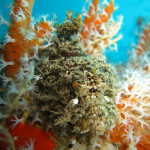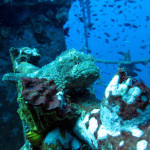Red Breasted Wrasse (Cheilinus fasciatus)
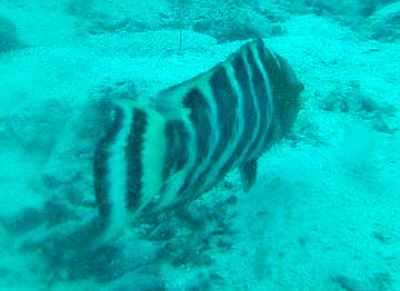
Image Copyright BB Divers
Observed: Koh Chang Reefs,
Observed By: BB Divers
You can’t see the breast of the fish pictured, but trust us, it’s red. The red-breasted wrasse (name like a tongue-twister) is an attractive white red and brown striped reef fish common to the waters of the Indo-Pacific region that grows to a maximum length of 40cm.
Red Breasted Wrasse Wikipedia
Orange-Spine Unicornfish (Naso Lituratus)
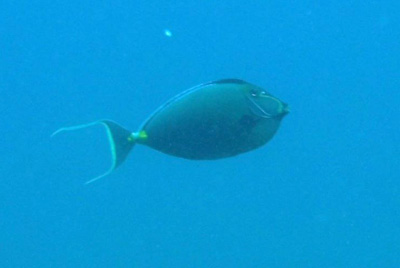
Image Copyright BB Divers
Observed: Koh Chang Reefs,
Observed By: BB Divers
Good grief. Carlos The Jackal didn’t have as many alises as this fish. Naso literatus can also be know as, wait for it, barcheek unicornfish, clown tang, masked unicornfish, naso tang, orange-spine surgeonfish, orange-spine unicornfish, Pacific orange-spine unicorn, poll unicornfish, redlip surgeonfish, smooth-head unicornfish, and striped unicornfish.
It is a common reef fish that grows up to 45cm in length and it can be found on reefs all around the Indian and Pacific oceans.
Orange-Spine Unicornfish Wikipedia
Masked Porcupinefish (Diodon liturosus)
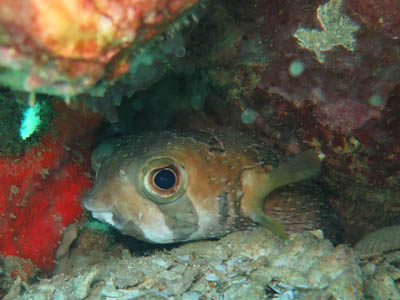
Image Copyright BB Divers
Observed: Koh Chang Reefs,
Observed By: BB Divers
The masked porcupinefish is also known as the black-blotched porcupinefish, but that’s frankly a rubbish name for this enigmatic little animal.
The first thing that you notice if you spot one whilst diving or snorkelling are the huge eyes that seem to follow you around.
It has scales that have modified into spines. When threatned it inflates its body by swallowing water and presents its spines to predators. And as a further disincentive it contains a powerful neurotoxin in several parts of its body. So don’t even think about eating it!
Masked Porcupinefish Wikipedia
Many-Spotted Sweetlips (Plectorhinchus chaetodonoides)
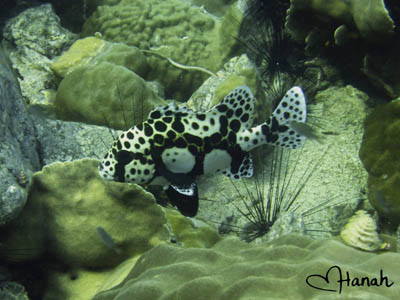
Image Copyright Hanah Weerkamp
Observed: Koh Chang Reefs,
Observed By: Hanah Weerkamp
The many-spotted sweetlips is also known as the harlequin sweetlips. It is a medium sized reef fish that can grow to 72cm in length and up to 7kg in weight. The adults have a distinctive black spots on a white background pattern but the juvenile form is quite different with an orange and white coloration that is similar to clownfishes. The one pictured is a semi-adult with yet another colour scheme. Confused? I am.
Many-Spotted Sweetlips Wikipedia
Longfin Bannerfish (Heniochus acuminatus)
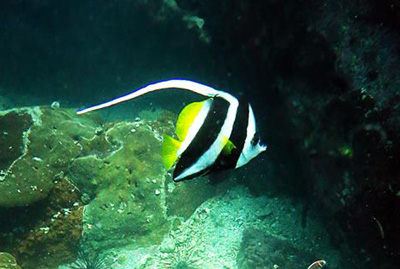
Image Copyright BB Divers
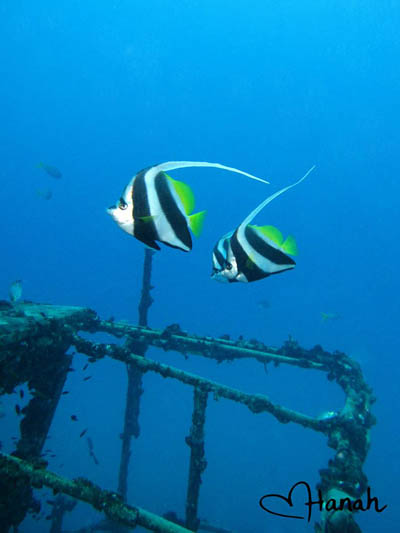
Image Copyright Hanah Weerkamp
Observed: Koh Chang Reefs,
Observed By: BB Divers, Hanah Weerkamp
The Longfin bannerfish is a relativeley small reef fish that is a plentiful dweller of reefs all across the Indo-Pacific region. They grow to a maximum length of 25cm and are easily identified by their striking black-white-yellow pattern and the huge dorasl fin that trails over a long distance behind the fish itself.
The Longfin bannerfish, also called the pennant coralfish, lives in mating pairs and survives on plankton in teh water and occasional invertebrates.
Longfin Bannerfish Wikipedia
Java Rabbitfish (Siganus javus)
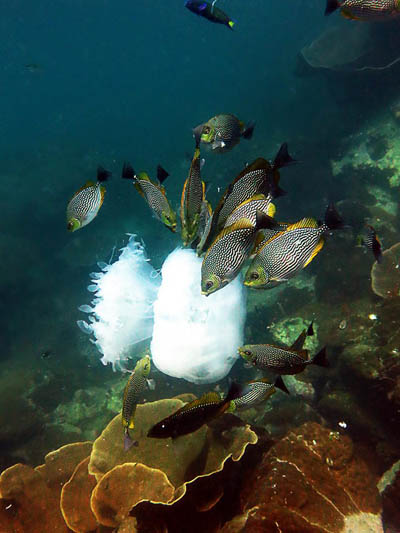
Image Copyright BB Divers
Observed: Koh Chang Reefs 2015
Observed By: BB Divers
The Java rabbitfish, also know as the streaked spinefoot is a colourful species of rabbitfish that can grow to a size of 55cm in the adult male.The research suggests that it is a herbivore that lives mainly on algae but the ones in the picture seem to be having a good old feed on that jellyfish so let’s suggest that it is also an occasional predator or scavenger.
Oh, and it has venomous spines on the dorsal fin – seems like everything in the ocean has a bit of poison somewhere or other.
Java Rabbitfish Wikipedia
Great Barracuda (Sphyraena barracuda)
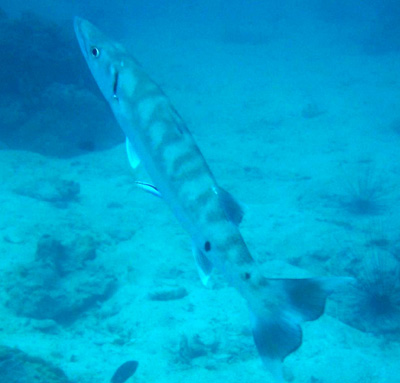
Image Copyright BB Divers
Observed: Koh Chang Reefs 2015
Observed By: BB Divers
The great barracuda is a large pelagic (open-water) fish that can occassionally grow up to two metres in length. It is a fast moving ocean predator and can reach speeds of up to 43km an hour as it chases the smaller fish that are its prey.
It is a widespread species that is found in tropical waters of all the major oceans.
Great Barracuda Wikipedia
Devil Scorpionfish (Inimicus filamentosus)
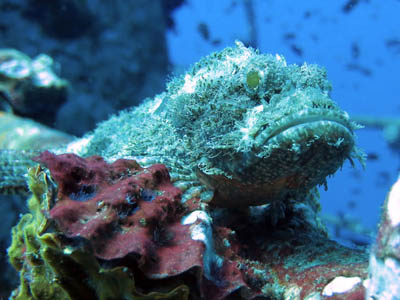
Image Copyright BB Divers
Observed: Koh Chang Reefs 2015
Observed By: BB Divers
It’s all in the name. If something is named after both Lucifer and a poisonous insect then it should be pretty clear that it is not a beast to mess with. And it isn’t. The Devil scorpionfish is a highly camouflaged reef predator that protects itself with venomous dorsal spines that have a highly toxic poison.
They feed on smaller fish by using their camouflage and a lightning fast attack to trap prey. They are nocturnal hunters and often bury themselves in sand during the day.
Devil Scorpionfish Wikipedia
Image Copyright Hanah Weerkamp
Image Copyright BB Divers
Ocellaris Clownfish (Amphiprion ocellaris)
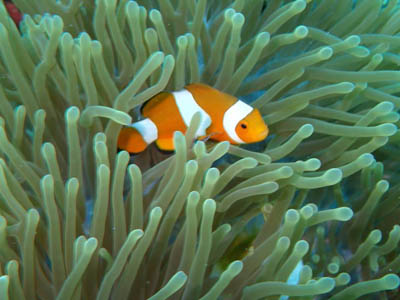
Image Copyright BB Divers
Observed: Koh Chang Reefs 2015
Observed By: BB Divers
Is this now the most recogniseable fish in the ocean? Finding Nemo brought the clownfish to fame in a far less threatening way than Jaws did for sharks.
The ocellaris clownfish is a species of anemonefish that lives in a symbiotioc relationship with the sea anemones that are its protector and home. It looks nearly but not quite the same as the Orange clownfish (11 dorsal spines versus 10 in case you’re wondering and slightly thicker black lines – species identification is hard!)
They are a small fish that grows to only 11cm in length and are found in the Eastern Indian Ocean and the Western Pacific)
Clark’s Anemonefish has a bright orange, black and white coloration and is a common resident of the anemones of Koh Chang’s coral reefs.
Ocellaris Clownfish Wikipedia
Bluestreak Cleaner Wrasse (Labroides dimidiatus)
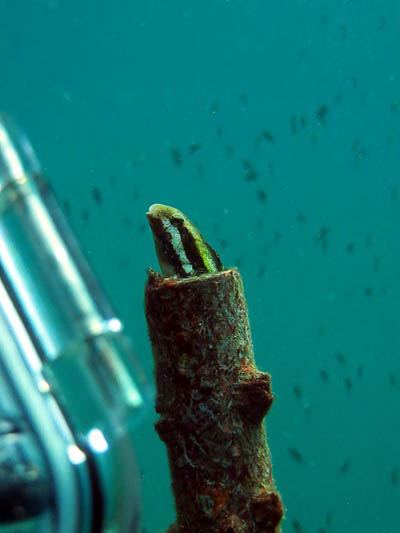
Image Copyright BB Divers
Observed: Koh Chang Reefs, 2015
Observed By: Hanah Weerkamp
The wrasse family are the carwashes of the ocean. These unique fishes subsist on the parasites and dead tissue that grow on other fish species. They establish cleaning stations where all kinds of fish swim up for a clean-up. This removes irritating and harmful parasites from the fish and provides a food source for the wrasse. Even sharks and other predatory species will call a truce with the wrasse in order for a much-needed cleanup.
Bluestreak cleaner wrasse Wikipedia










